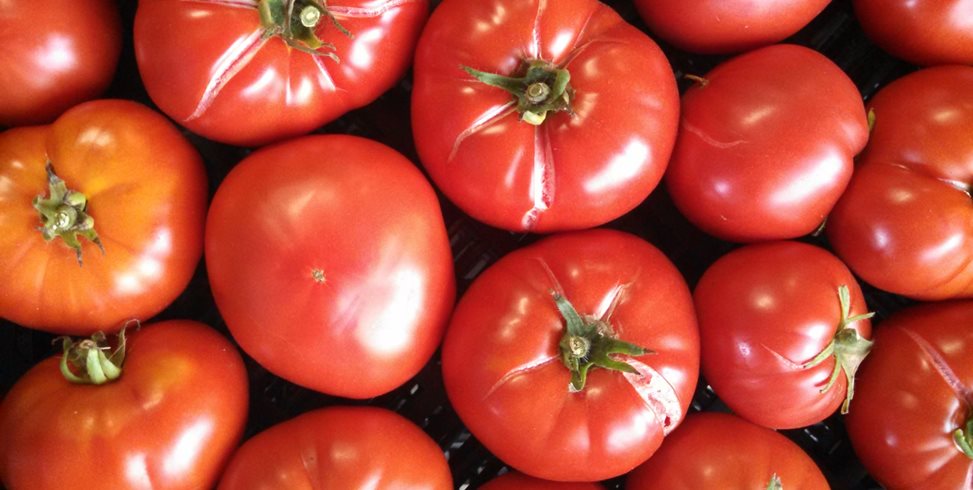START BOOKING YOUR TRIP TO
** Please note that we get a small commission if you book via our referral links. We use this to invest in new foodie content and to update the Greece Foodies website.
Greek tomatoes are one of the most beloved ingredients in Greek cuisine. Grown in the warm Greek climate, these tomatoes offer a unique flavor and texture that can’t be found anywhere else. From juicy heirloom varieties to classic beefsteaks, Greek tomatoes come in all shapes and sizes. They are a versatile and essential ingredient in Greek cuisine, perfect for making sauces, salads, sandwiches, and more.
Whether you’re looking for a simple salad or something more complex, Greek tomatoes can provide just the right flavor to complete your dish!
What makes Greek tomatoes unique?
Our country’s climate guarantees that it will grow the most extraordinary tomatoes. And, since costs are mostly set, the only way to distinguish is to invest in quality and taste.
Greek farmers and tomato suppliers closely adhere to the most recent regulations while researching the most recent trends regarding safety, innovation, and uniformity in size, color, and taste. In particular, in the case of hydroponics, a growing kind of culture, we can feed plants with all the required nutrients at the correct growth stage.
Greek tomatoes: Products
The European market is the primary destination for Greek tomato exports, especially in Western Europe. Specifically, the double and triple-concentrated paste is transported to remanufacturing businesses in the United Kingdom, Poland, the Netherlands, and Germany. Canned tomatoes are also shipped to the United Kingdom, Belgium, and the Netherlands.
As a result, it is fair to conclude that a significant portion of export turnover originates in adjacent or geographically near nations. On the other hand, Greek sauces are primarily directed toward the Japanese market, Bulgaria, Saudi Arabia, and the United States. The Greek tomato business exports just a tiny amount of sauces and ketchup. Greek firms mainly export pastes and reasonably high quantities of canned tomatoes.
Stuffed tomatoes: Recipe
Greek-filled tomatoes, also known as yemista/gemista, are a nutritious, delicious lunch that shouts Greek tastes! This dish is ideal for a family dinner or entertaining guests. Everyone will like it with fresh crusty bread, feta cheese, and red or white wine. You can also use other stuffed vegetables with this recipe.
This is a classic and traditional Gemista recipe. The filling is loaded with excellent fresh herbs and some briny add-ins.
Ingredients
- Tomatoes
Medium to large beefsteak or heirloom tomatoes for this dish. Preferably ripe but firm tomatoes since they hold up better when roasted.
- Crushed tomatoes
There is usually a lot of tomato pulp that can be used. However, add extra crushed tomatoes – usually canned or bottled ones. If you prefer your rice to have less sauce or be less tomato-based, replace it with water or broth as needed to cook rice properly.
- Rice
Use long-grained rice, but Arborio rice mixture, quinoa, and wild rice have all been used in this dish. Just be sure to modify the amount of water or broth you need to boil since various grains may require a little more water to cook halfway.
- Pine nuts
You may substitute chopped almonds or leave them out if you are sensitive to nuts.
- Olives
You can use any kind you choose. For example, I like the kalamata olives. You can also add fresh dill, salt, and pepper, minced garlic. A vegetarian version of the recipe without meat!
- Feta
Serve your Gemista with feta cheese, and include it within the filling. We usually make it this way. You can also use Parmesan cheese instead of feta if you like.
Potatoes are an optional addition to the pan’s foundation, and simmer with the tomatoes, but feel free to leave them out if you don’t like potatoes. If you want it less saucy, skip the sauce and replace it with a little additional broth or water at the bottom of the pan and a sprinkle of olive oil.
Execution: Cooking time
- Remove the tomato shell and scoop out the meat, reserving it.
- Place the hollowed-out tomatoes in a large baking dish.
- Prepare simple rice, vegetable, and herb filling on the stovetop. Cook until the rice is half done.
- Fill veggies with rice stuffing. Tuck potato wedges between the packed vegetables or below the tomatoes.
- Bake with a layer of tomato sauce and olive oil on top. Serve with crusty bread and a large slice of feta cheese.
So, if you want to add some Greek flare to your next meal, look no further than the juicy gems of the country-Greek fresh tomatoes!
















